If you want to transform your relationships, these 12 books on attachment styles are a game-changer. They cover everything from understanding your style, healing insecure patterns, and building secure connections, to practical exercises and scientific insights. With clear explanations and relatable examples, I found these books both inspiring and actionable. Keep exploring, and you’ll gain the tools to foster healthier, more fulfilling relationships for yourself and those you care about.
Key Takeaways
- The recommended books offer practical insights to understand and change attachment patterns, enhancing relationship dynamics.
- They include accessible guides, workbooks, and science-based strategies for self-awareness and mutual responsiveness.
- Resources cover various attachment styles—secure, anxious, avoidant, and disorganized—to address diverse relational challenges.
- Many focus on healing childhood wounds, reducing insecurity, and fostering healthy, secure connections.
- These books are suitable for both individuals and couples seeking to transform their attachment-related behaviors and improve intimacy.
The New Science of Adult Attachment
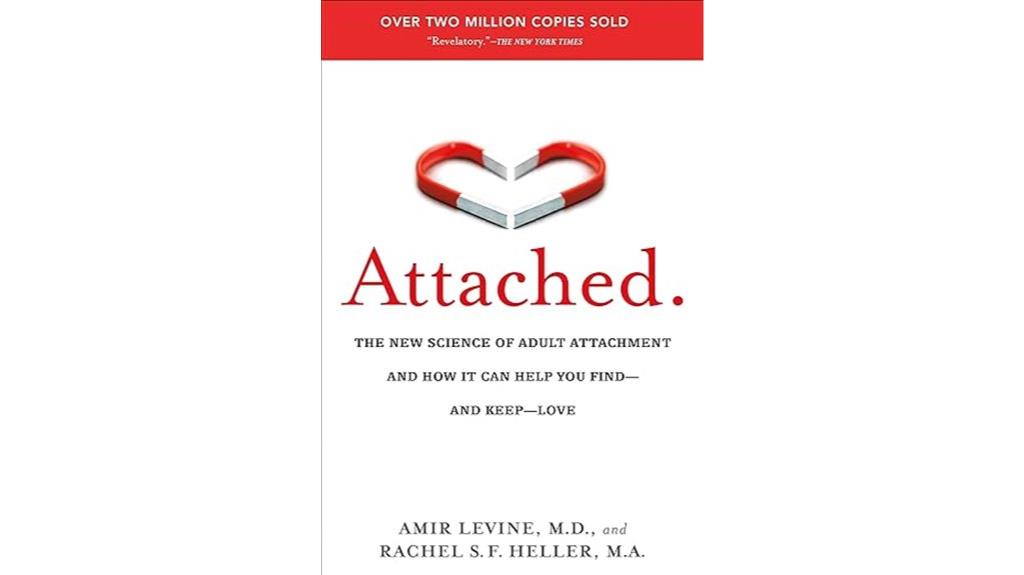
If you’re looking for a straightforward, accessible introduction to attachment styles, “The New Science of Adult Attachment” is an excellent choice. I found it easy to understand, even without a background in psychology. The book explains secure, anxious, avoidant, and briefly touches on fearful avoidant styles through real-life examples and simple quizzes. Its practical approach relies on empathy, self-awareness, and intuition, making complex ideas relatable. Many readers, including myself, have gained valuable insights into their relationship patterns. It’s light, engaging, and perfect for anyone curious about personal growth or improving connections without feeling overwhelmed by technical jargon.
Best For: individuals seeking an easy, practical introduction to attachment styles to enhance self-awareness and relationship understanding without requiring prior psychology knowledge.
Pros:
- Clear, straightforward explanations suitable for beginners
- Uses real-life examples and simple quizzes for better engagement
- Empowers readers with practical tools for improving relationships and self-awareness
Cons:
- Brief coverage of the fearful avoidant attachment style
- Some readers may desire more in-depth theoretical or scientific detail
- Focuses mainly on romantic relationships, less on other relationship types
The Attachment Theory Workbook

The Attachment Theory Workbook stands out as an ideal resource for individuals seeking practical, accessible tools to understand and improve their relational patterns. I appreciate how it simplifies complex ideas about attachment styles into straightforward language, making it easy to grasp and apply. The exercises and assessments help uncover root causes of insecurities, improve communication, and build trust. I’ve found that its compassionate tone encourages honest self-reflection without judgment. Whether you’re new to attachment theory or looking to deepen your understanding, this workbook offers actionable steps to foster healthier relationships and personal growth. It’s a valuable tool for anyone committed to positive change.
Best For: individuals seeking accessible, practical tools to understand and improve their attachment styles and relational patterns.
Pros:
- Simplifies complex attachment concepts into straightforward, easy-to-understand language.
- Contains practical exercises and assessments that promote self-discovery and relational growth.
- Encourages compassionate self-reflection, reducing shame and fostering hope for change.
Cons:
- Occasionally contains errors or confusing shifts in perspective that may hinder understanding.
- Questions can sometimes feel superficial or lacking in depth.
- Less comprehensive coverage of disorganized or fearful-avoidant attachment styles.
Wired for Love: Understanding Your Partner’s Brain and Attachment Style
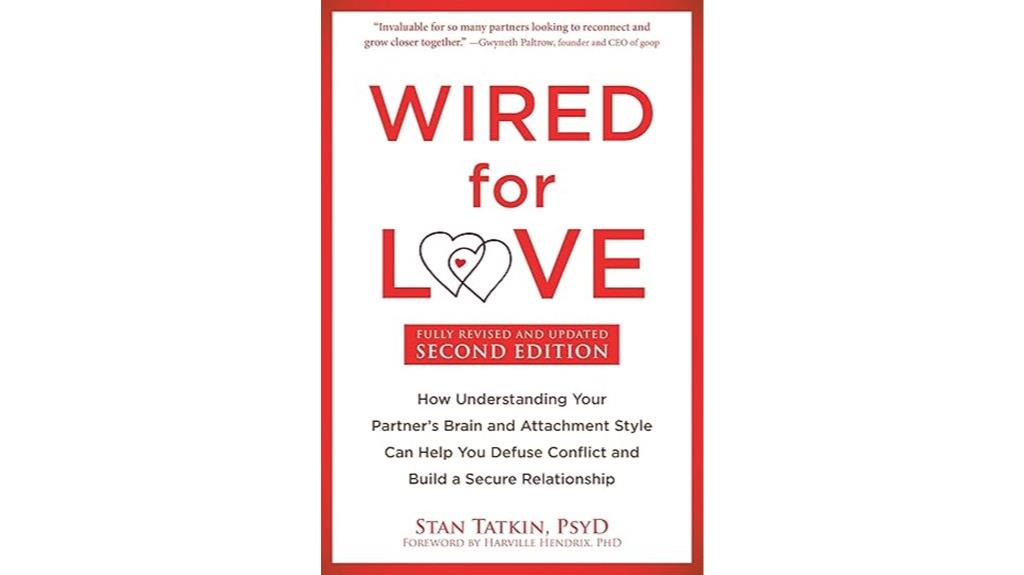
Wired for Love: Understanding Your Partner’s Brain and Attachment Style is an excellent choice for couples and therapists seeking practical, science-based insights into relationship dynamics. Tatkin’s book highlights how understanding brain wiring and attachment styles can deepen connection and safety. It introduces the “couple bubble,” a secure space where partners prioritize each other’s needs. The book uses clear analogies, like rational versus primitive brain functions, to explain triggers and reactions. Practical tools like “the tether” and “fully present listening” help de-escalate conflicts. Overall, it’s a compassionate, accessible guide that empowers couples to build lasting, supportive relationships through self-awareness and mutual responsiveness.
Best For: couples and therapists interested in science-based strategies to deepen emotional connection, improve communication, and foster secure attachment in relationships.
Pros:
- Provides clear, practical tools grounded in neuroscience and attachment theory for immediate application.
- Enhances self-awareness and empathy by helping partners understand their own and each other’s relational patterns.
- Accessible and engaging, suitable for both professionals and laypeople seeking relationship growth.
Cons:
- Some readers may find certain sections overly simplistic or wish for more advanced psychological techniques.
- Minor issues with book condition or formatting, such as skimming or worn pages, reported by a few readers.
- The focus on practical tools may require ongoing effort to implement consistently for lasting results.
Anxious Attachment Recovery and Healing Book
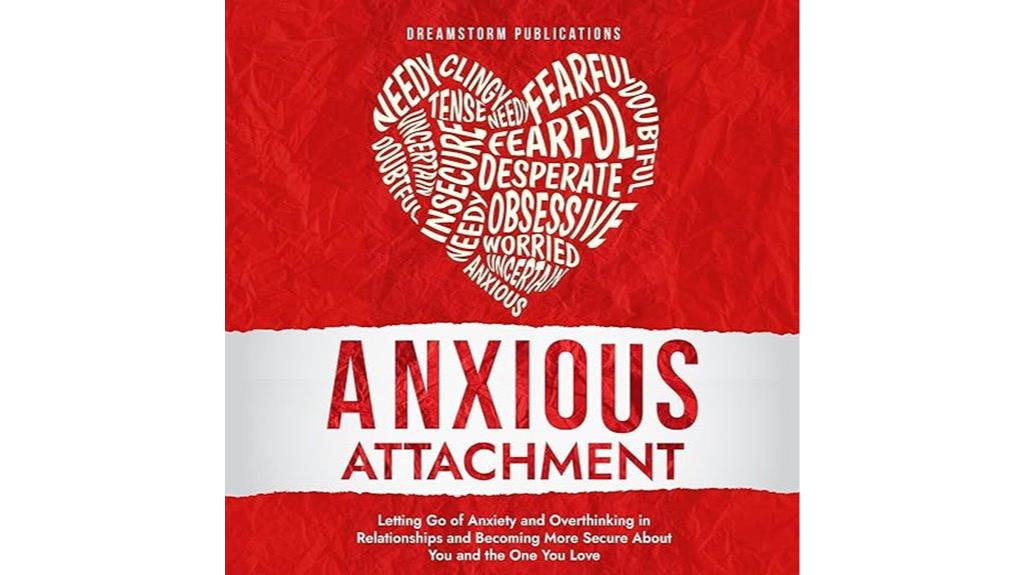
Those seeking compassionate guidance to heal anxious attachment will find this book especially helpful. It offers a warm, empathetic tone that helps you understand the roots of your attachment style and its impact on relationships. Through relatable stories and expert insights, it highlights how past trauma and family dynamics shape your fears and overthinking. The book provides practical tools like mindfulness, boundary-setting, and communication exercises to foster self-awareness and emotional resilience. Most importantly, it emphasizes that healing is a lifelong journey, encouraging patience, self-love, and ongoing growth. This resource empowers you to rewire your mindset and build healthier, more secure connections.
Best For: individuals seeking compassionate, practical guidance to understand and heal anxious attachment patterns through self-awareness and emotional growth.
Pros:
- Empathetic and approachable tone that makes complex attachment concepts accessible
- Practical tools like mindfulness, boundary-setting, and communication exercises for real-world application
- Emphasizes long-term growth, self-love, and ongoing healing as a lifelong journey
Cons:
- May require consistent effort and patience as healing is a gradual process
- Some readers might find the content too gentle or not as in-depth on certain therapeutic techniques
- Not a quick fix; it promotes holistic healing, which may be challenging for those seeking immediate results
Attachments: Why You Love, Feel, and Act the Way You Do
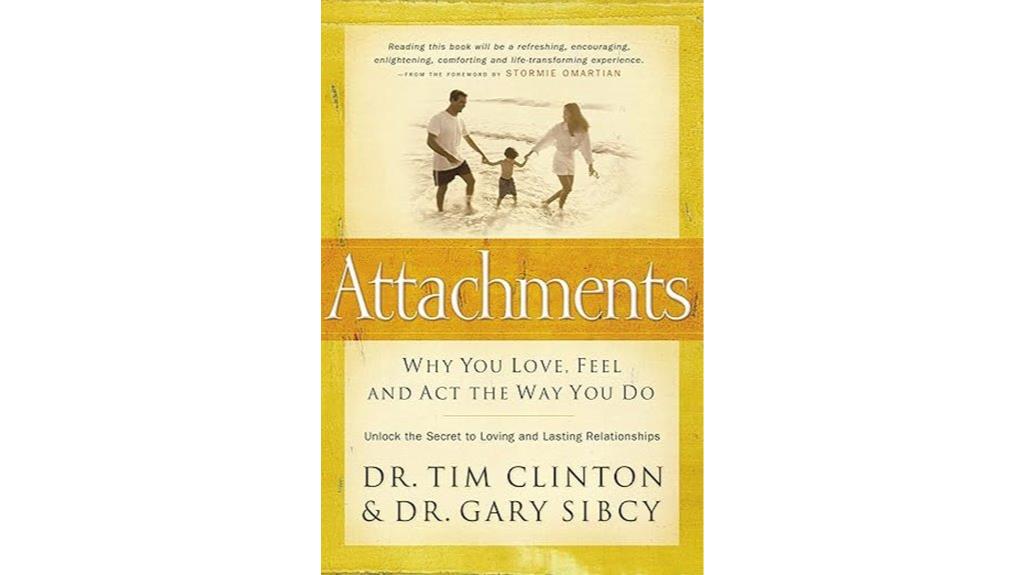
If you’re someone seeking to understand why you love, feel, and act the way you do, this book offers essential insights into attachment styles. It reveals how childhood trauma, neglect, and early relationships shape adult behaviors, often leading to insecure attachment patterns. The book emphasizes that attachment issues can contribute to societal problems like divorce, addiction, and violence, while MRI studies show they can even affect brain function. With practical steps for healing, it guides you toward self-awareness, emotional security, and healthier relationships. Rooted in faith and personal growth, it’s a powerful resource for transforming your relational life.
Best For: individuals seeking to understand and heal their attachment styles to foster healthier relationships and personal growth rooted in faith.
Pros:
- Provides clear, practical guidance on attachment theory and healing steps
- Integrates biblical principles to support emotional and spiritual growth
- Offers valuable insights for parents, couples, and anyone interested in personal development
Cons:
- Lengthy content may require significant time commitment to fully absorb
- Some readers find the narration audio version unpleasant and prefer the physical or Kindle format
- Achieving secure attachment is an ongoing process that demands consistent effort and self-awareness
Attachment Workbook: Transform Patterns into Loving Relationships
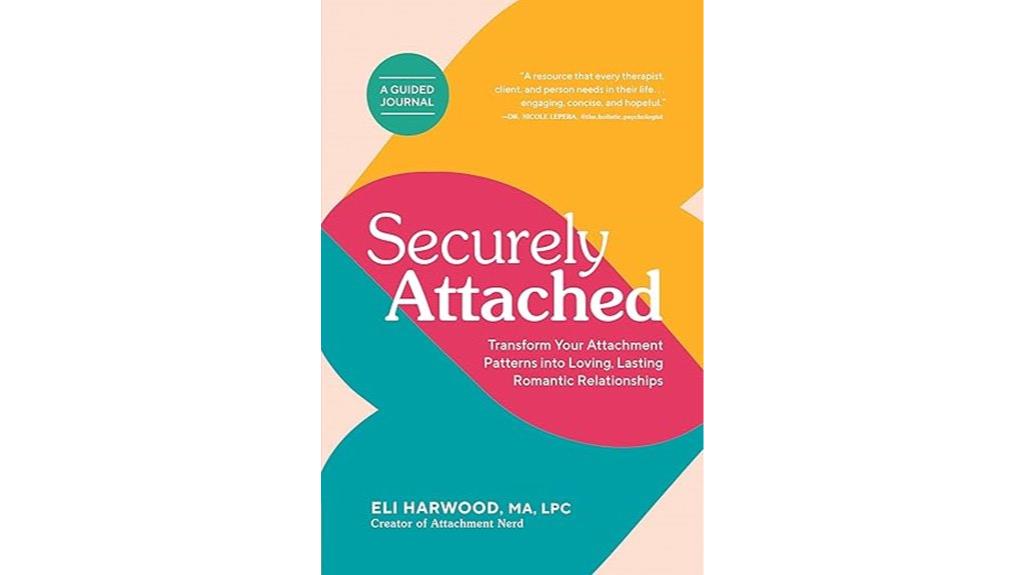
The “Attachment Workbook: Transform Patterns into Loving Relationships” is an excellent choice for individuals who want practical tools to understand and change their attachment behaviors, especially if they’re prepared to engage in deep self-reflection. Eli Harwood’s warm, encouraging 161-page workbook offers clear guidance on exploring childhood origins, current attachment styles, and pathways to secure attachment. It includes reflection prompts, actionable advice, and visual reminders to reinforce healthy behaviors. While some prompts can be emotionally triggering, the book’s accessible language and relatable tone make complex concepts easier to grasp. It’s a valuable resource for anyone committed to breaking negative patterns and fostering healthier, more secure relationships.
Best For: individuals seeking practical, self-guided tools to understand and transform their attachment patterns into secure, loving relationships, especially those prepared for deep self-reflection and emotional growth.
Pros:
- Clear, accessible language that simplifies complex attachment concepts for beginners and experienced readers alike
- Includes actionable prompts, reflection questions, and visual reminders to reinforce healthy behaviors
- Supports ongoing self-awareness and growth, making it a useful supplement to therapy or personal development efforts
Cons:
- Some prompts can be emotionally triggering, requiring emotional resilience and possibly professional support
- Small print and binding issues may make writing and use less user-friendly
- The tone can sometimes feel condescending or immature, which may diminish the perceived seriousness of the content
Attachment Styles Workbook: Transform Behavior Patterns to Secure Relationships
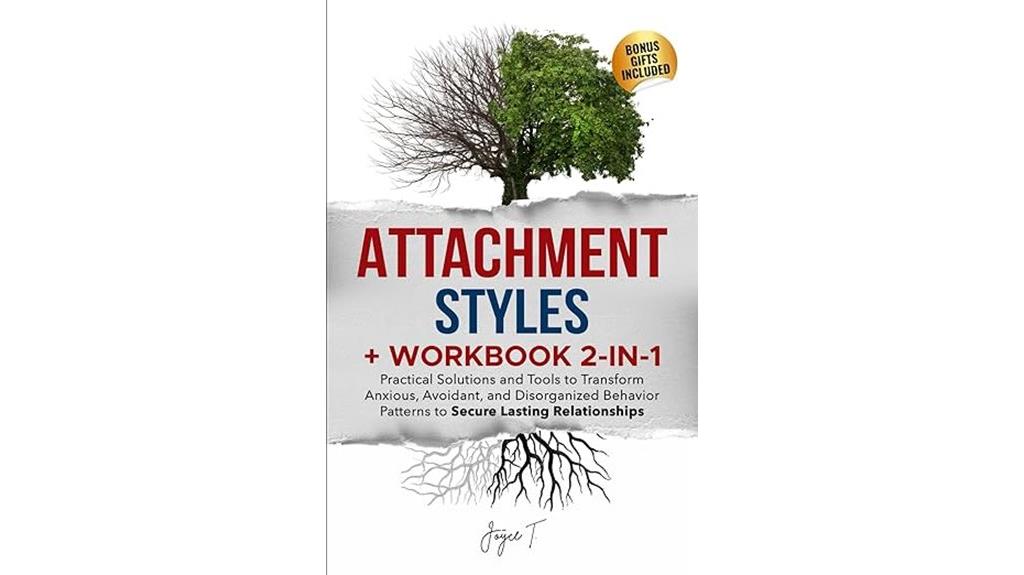
Anyone looking for a practical, easy-to-follow guide to transforming attachment behaviors will find “Attachment Styles + Workbook 2-in-1” especially valuable. This book combines clear explanations of attachment theory with actionable exercises that help you understand how childhood experiences shape your adult relationships. It offers tools like self-assessment questionnaires, grounding techniques, and intimacy exercises to foster self-awareness and emotional regulation. The workbook format encourages active participation, making complex concepts accessible and applicable. Whether you’re seeking healthier connections or personal growth, this resource provides tangible strategies to shift insecure patterns into secure, loving relationships.
Best For: individuals seeking a straightforward, practical guide to understanding and transforming attachment behaviors to foster healthier, secure relationships.
Pros:
- Clear, jargon-free explanations make complex attachment concepts accessible for beginners.
- Interactive exercises and self-assessment tools promote active self-discovery and personal growth.
- Practical techniques like grounding and intimacy exercises can be applied immediately to improve relationships.
Cons:
- Content may be too basic for those looking for in-depth academic or scholarly analysis of attachment theory.
- The workbook format emphasizes activities over traditional journaling, which may not suit all learning styles.
- Some readers might find the explanations limited in depth, requiring supplementary resources for advanced understanding.
Understanding Attachment Style and Theory
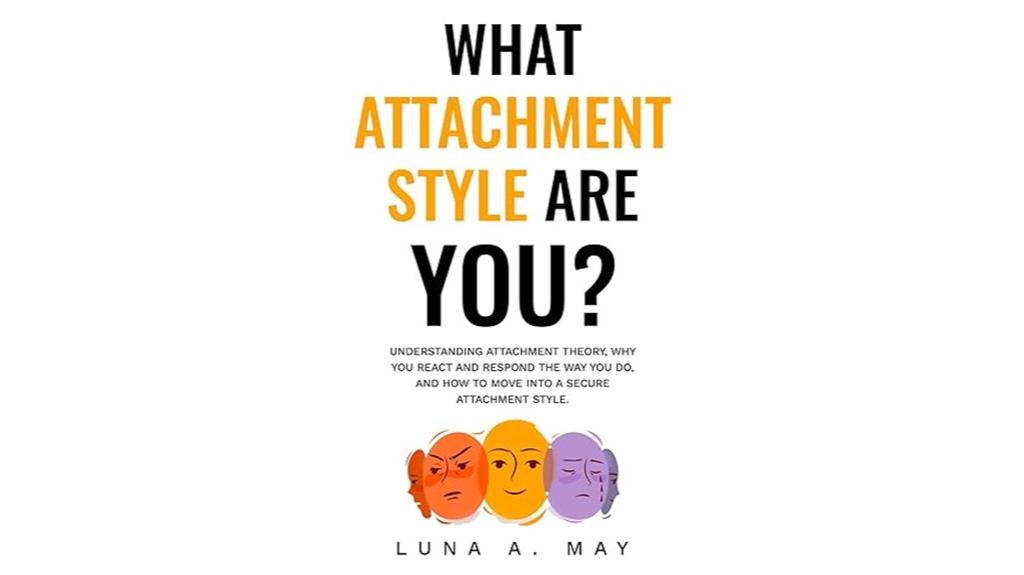
Understanding attachment style and theory is essential for anyone enthusiastic to improve their relationships and self-awareness. I’ve learned that early childhood experiences shape how we connect, communicate, and respond emotionally throughout life. There are four main attachment styles: Secure, Anxious-Preoccupied, Dismissive-Avoidant, and Fearful-Avoidant. These styles exist on a spectrum and can change with awareness and effort. Recognizing your attachment pattern helps explain recurring relationship issues and emotional reactions. The theory emphasizes that attachment behaviors are learned and modifiable, offering hope for healthier, more fulfilling connections across romantic, familial, and social relationships.
Best For: individuals seeking to understand and improve their relationship patterns through self-awareness and emotional healing.
Pros:
- Provides clear explanations of complex attachment concepts with relatable examples
- Includes practical exercises for self-reflection and inner child healing
- Supports long-term relationship growth by promoting emotional regulation and secure attachment traits
Cons:
- May require consistent effort and time to see significant changes
- Some exercises might be challenging for those with deep-seated childhood wounds
- The material could be less suitable for those looking for quick fixes or superficial insights
The Practical Anxious Attachment Recovery Workbook
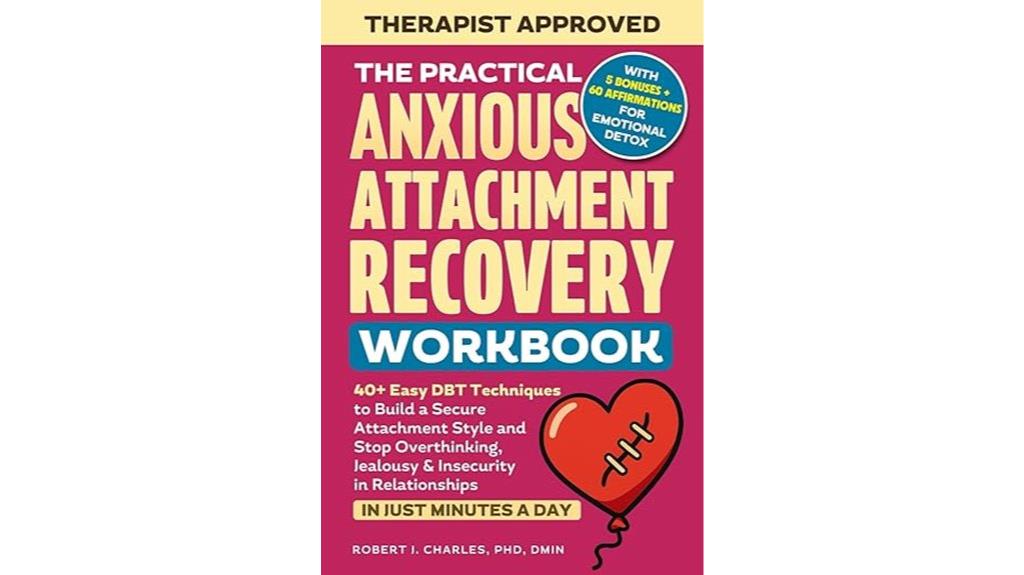
If you’re seeking practical tools to overcome anxious attachment patterns, the Practical Anxious Attachment Recovery Workbook stands out as an accessible and effective resource. It offers step-by-step exercises, including over 40 DBT techniques like journaling, mindfulness, and self-affirmations, to help you manage intense emotions and build security. Users report feeling calmer, more confident, and better equipped to handle relationship challenges. Designed for self-paced use, it complements therapy and supports emotional healing. Its compassionate tone, relatable stories, and practical tools make it a valuable guide for anyone committed to transforming their attachment style and cultivating healthier, more secure relationships.
Best For: individuals seeking practical, self-guided tools to overcome anxious attachment patterns and build healthier relationships.
Pros:
- Offers over 40 evidence-based DBT exercises that are easy to follow and adaptable.
- Combines compassionate tone with relatable stories to foster a supportive learning environment.
- Enhances therapy by providing practical exercises that promote emotional regulation and self-awareness.
Cons:
- Designed primarily for self-paced use, which may require additional professional support for deep trauma work.
- Some users may find the exercises repetitive if not practiced consistently.
- Not a substitute for therapy but a supplemental resource, so those with severe attachment issues may need additional guidance.
Anxious Attachment Workbook for Women
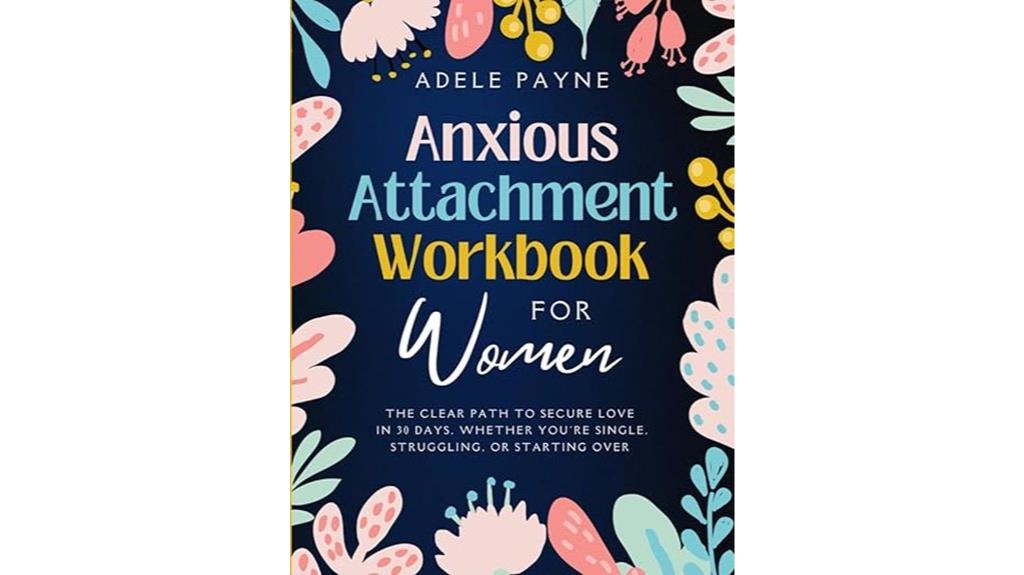
The “Anxious Attachment Workbook for Women” by Adele Payne is especially suited for women who want a structured, step-by-step guide to overcoming attachment-related insecurities. Over 30 days, it offers daily exercises, journaling prompts, and practical tools rooted in Cognitive Behavioral Therapy to help you reframe negative thoughts, heal emotional wounds, and build security. The workbook emphasizes gradual change through the SECURE Pathway, focusing on awareness, confidence, and stronger connections. Many women find it validating and empowering, helping them understand their patterns, reduce anxiety, and foster healthier, more fulfilling relationships. It’s an accessible, practical resource for transforming attachment insecurities into emotional resilience.
Best For: women seeking a structured, practical approach to overcoming attachment insecurities and building healthier, more secure relationships.
Pros:
- Offers a clear, step-by-step 30-day plan with daily exercises and reflections.
- Utilizes Cognitive Behavioral Therapy techniques to reframe negative thoughts and promote emotional healing.
- Validates women’s feelings and fosters confidence, making the process empowering and relatable.
Cons:
- The workbook may require consistent commitment over the 30 days to see significant results.
- Some users might prefer more personalized or in-depth therapy beyond the workbook format.
- As a self-guided tool, it may not address complex attachment issues that need professional intervention.
How to Heal Anxious Attachment Style Workbook
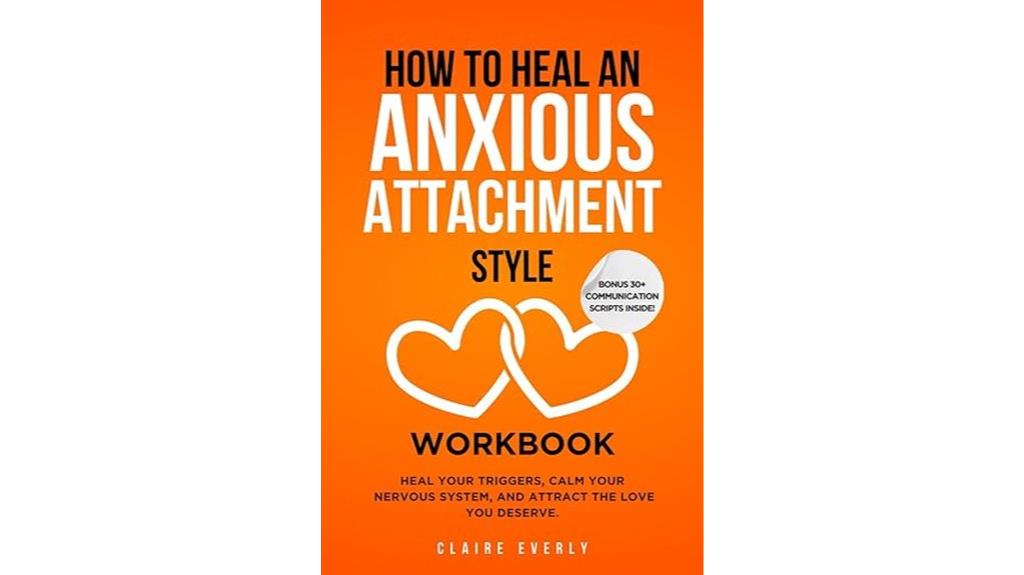
Anyone struggling with anxious attachment and seeking practical tools will find the “How to Heal Anxious Attachment Style Workbook” especially valuable. This workbook offers clear, actionable exercises to identify and understand the roots of your attachment style, helping you recognize patterns of insecurity and overthinking. It emphasizes rewiring your nervous system with calming visualizations, self-awareness prompts, and communication scripts that boost confidence. By focusing on self-trust and emotional regulation, it guides you toward building secure, authentic relationships. Many readers report feeling more in control, less anxious, and better equipped to foster healthy connections through its compassionate, straightforward approach.
Best For: individuals struggling with anxious attachment who want practical, actionable tools to understand and heal their relationship patterns.
Pros:
- Provides clear, step-by-step exercises and prompts for self-awareness and emotional regulation
- Focuses on rewiring the nervous system to foster feelings of safety and confidence in love
- Uses relatable language and realistic examples to make attachment healing accessible
Cons:
- May require consistent effort and practice to see significant progress
- Some readers might prefer more in-depth psychological or therapeutic techniques
- The workbook format might be less suitable for those seeking personalized coaching or therapy guidance
Overcoming Avoidant Attachment Style: Practical Guide to Secure Relationships
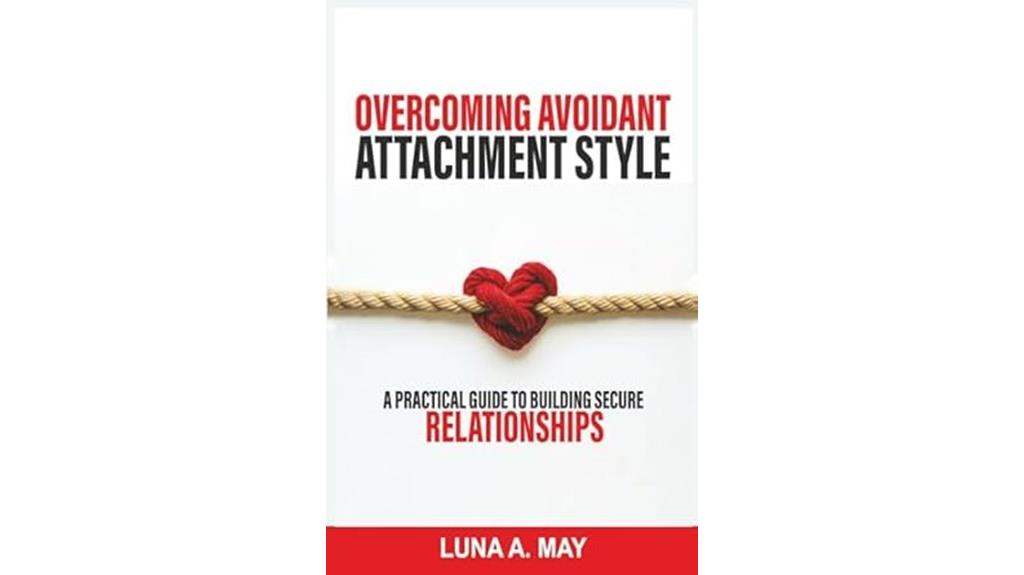
This practical guide is especially valuable for those who recognize patterns of emotional distance and fear of intimacy in themselves but still long for deeper connection. I found the explanations compassionate and straightforward, helping me understand that avoidant behaviors stem from underlying fears rather than a lack of desire for love. The book offers practical tools like the CARE framework and reflection exercises that made meaningful change feel achievable. With a focus on emotional healing and honest communication, it reassured me that building secure relationships requires patience and self-compassion. If you’re ready to break free from avoidance and foster authentic closeness, this guide provides clear steps to get there.
Best For: individuals who recognize their emotional distance and fear of intimacy but are committed to fostering genuine, secure connections.
Pros:
- Provides compassionate, clear explanations of avoidant attachment patterns.
- Offers practical, easy-to-remember tools like the CARE framework and reflection exercises.
- Emphasizes emotional healing, self-awareness, and patience as keys to relationship growth.
Cons:
- May require consistent practice and patience, which can be challenging for some readers.
- Some concepts may feel abstract without dedicated effort or guidance.
- The focus on self-healing might be less effective without support from a partner or therapist.
Factors to Consider When Choosing Attachment Style Books

When choosing an attachment style book, I focus on how clearly it explains concepts and whether it offers practical exercises you can apply. I also consider the depth of content to ensure it matches your familiarity with the topic, along with the tone and style that resonate with you. Ultimately, I think about who the book is meant for, so it truly meets your needs and goals.
Clarity of Concepts
Choosing a book on attachment styles becomes easier when the concepts are presented clearly and simply. I look for books that define key terms like secure, anxious, avoidant, and disorganized attachment in straightforward language. Good books use relatable examples and everyday scenarios to show how attachment patterns show up in real relationships, making the ideas easier to grasp. The best resources break down complex psychological theories into digestible, jargon-free explanations, ensuring I don’t get lost in technicalities. Visual aids like diagrams or summaries are also helpful, reinforcing my understanding. Clarity means avoiding overly abstract language or confusing terminology, so I can focus on learning without frustration. When concepts are clear, I can better apply what I learn to improve my relationships.
Depth of Content
Once I find a book that clearly explains attachment concepts, I consider how profound the content goes to match my interests and needs. More detailed books often explore into theoretical foundations, developmental origins, and complex behaviors tied to each attachment style. They include detailed case studies, scientific research, and psychological frameworks that deepen understanding. If I want a comprehensive view, I look for books that explore additional patterns like disorganized or fearful-avoidant styles. These books usually feature extensive exercises, self-assessment tools, and reflection prompts for personal growth. The level of detail influences the book’s length and complexity, so I choose based on whether I prefer scholarly insights or practical summaries. Ultimately, depth of content helps me find a resource that truly resonates with my journey.
Practical Exercises
Practical exercises in attachment style books can considerably enhance your self-awareness and promote healing, but their effectiveness depends on how accessible and engaging they are. I look for books that include clear self-assessment questionnaires, reflection prompts, and behavioral tasks that encourage active participation. Techniques like mindfulness, grounding, and journaling are especially helpful for managing attachment-related anxiety or avoidance. Repeating activities such as visualizations or communication scripts can reinforce healthier relationship habits over time. I also value exercises that facilitate inner child work or boundary setting, which deepen understanding and healing. The key is consistency—practical, manageable activities that I can incorporate into daily life ensure sustained progress. Choosing books with user-friendly exercises keeps me motivated and committed to my growth journey.
Style and Tone
The style and tone of an attachment style book can considerably influence how comfortable and motivated you feel during your reading journey. A book with a warm, compassionate tone helps you feel understood and supported, especially when delving into vulnerable topics like attachment wounds or relationship patterns. Clear, straightforward language with relatable examples makes complex concepts easier to grasp, which is especially helpful if you’re new to psychology. Some books adopt a humorous or lighthearted style, making learning more approachable, though this might sometimes lessen the perceived seriousness. Ultimately, the tone should match your preferences—whether you seek nurturing guidance, motivational insights, or evidence-based professionalism—to assure a more engaging and meaningful experience.
Target Audience
Choosing the right attachment style book depends heavily on your background, goals, and current understanding of psychology. Knowing your target audience helps guarantee the content matches your needs, whether you’re a beginner, an advanced learner, or a professional. Books aimed at a general audience usually feature accessible language, real-life examples, and practical exercises that promote self-discovery. If you’re part of a specific group—like couples, parents, or therapists—look for resources tailored with relevant strategies and scenarios. Additionally, consider your age, relationship status, and psychological knowledge level to select a book that’s easy to understand and apply. Picking the right book makes your journey toward better relationships more engaging, effective, and personalized.
Scientific Foundations
When selecting an attachment style book, it’s essential to verify that the information is grounded in solid scientific research. Reliable books draw on foundational studies by Bowlby and Ainsworth, which established the biological and emotional roots of attachment. Look for works that reference longitudinal studies, neuroimaging, and behavioral assessments that show how early experiences shape adult relationships. A good book will cite peer-reviewed research, neuropsychological findings, and clinical insights, ensuring the concepts are evidence-based. Additionally, consider whether the book explains how attachment varies across cultures, genders, and developmental stages, supported by diverse research. Choosing a book with a strong scientific foundation guarantees you’re learning from validated, credible sources rather than anecdotal or speculative claims.
Accessibility and Ease
Understanding the scientific basis of attachment styles helps guarantee the information is credible, but it’s equally important that the book’s presentation makes the concepts accessible. When choosing a book, look for clear, simple language that makes ideas easy to grasp, regardless of your reading level. Practical exercises, relatable examples, and reflection prompts can deepen your understanding and help you apply insights to your life. A straightforward structure, like summaries, bullet points, or step-by-step guides, enhances readability and keeps you engaged. Avoid books filled with technical jargon or complex psychology terms, which can be overwhelming. Visual aids, quizzes, and clear explanations support active learning and reinforce concepts, making the journey into attachment styles both approachable and effective.
Frequently Asked Questions
Which Attachment Style Is Most Common in Adults?
The most common attachment style in adults is anxious attachment. I’ve noticed many people, including myself at times, struggle with feeling insecure or worried about their partner’s feelings. This style often develops from inconsistent caregiving early in life. Understanding this has really helped me improve my relationships. Recognizing anxious attachment allows us to work on building trust and creating healthier, more secure connections with others.
Can Attachment Styles Change Over Time?
Think of attachment styles as gardens; they can flourish or fade over time. Yes, they can change. Life experiences, therapy, and self-awareness act like nurturing rain and sunlight, helping your emotional garden grow healthier. I’ve seen people transform from insecure to secure attachments through effort and reflection. So, don’t feel stuck—your attachment style isn’t fixed. With intention, you can cultivate healthier relationships and emotional resilience.
Are There Specific Books for Parenting Attachment Styles?
Yes, there are specific books on parenting attachment styles that can really help. I recommend “Attached to Good” by Karen Feltham and “The Whole-Brain Child” by Daniel J. Siegel and Tina Payne Bryson. These books offer practical advice on understanding your child’s attachment needs and fostering healthy emotional development. I found them insightful and empowering, helping me create stronger bonds and nurture my child’s sense of security.
How Do Cultural Differences Influence Attachment Styles?
I’ve found that cultural differences substantially shape attachment styles. For instance, some cultures emphasize independence, fostering secure or avoidant attachments, while others prioritize interdependence, nurturing anxious or ambivalent bonds. I’ve investigated studies showing how parenting practices, societal norms, and community values influence attachment behaviors. Understanding these differences helps me appreciate diverse relationship dynamics. It’s fascinating how cultural context molds our emotional connections, making awareness essential for healthier, more empathetic relationships worldwide.
What Are Signs of Insecure Attachment in Relationships?
Insecure attachment shows up in relationships through constant jealousy, difficulty trusting your partner, or feeling anxious when you’re apart. You might cling to your partner or push them away out of fear of rejection. I’ve noticed signs like emotional withdrawal, overanalyzing their actions, or feeling unworthy of love. Recognizing these patterns is the first step toward understanding yourself better and working on building healthier, more secure connections.
Conclusion
Exploring these books is like planting seeds in a garden of understanding, each one helping your relationships flourish in sunlight and warmth. As you nurture your attachment style, you’ll see your connections blossom into resilient, heartfelt bonds. Remember, this journey is yours to cultivate—every page turned is a step toward a more secure and loving future. Let these books be the guiding stars steering you toward brighter, more fulfilling relationships.









